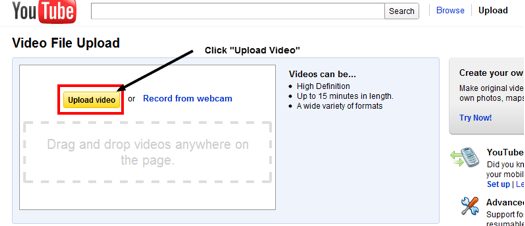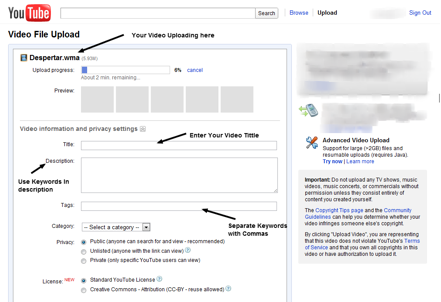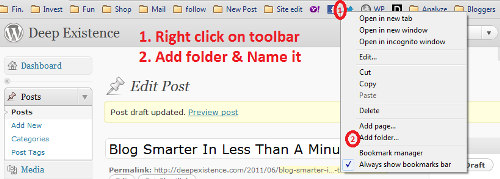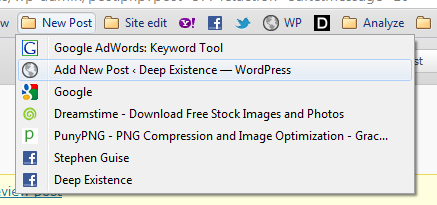 | Make Money Online http://www.problogger.net рекомендовать друзьям >> |
- The Blogger's Ultimate Guide to YouTube Success
This guest post is by Hasan of MarketingTheInternet.
YouTube, the second largest search engine right after Google, in 2010 broke the record of uploading more than 24 hours of video per minute! YouTube has also shattered the millstone of over 700 billion video views.
YouTube is an excellent platform for bloggers to build a brand, connect, and provide value to millions of people at once. It can ultimately help you increase traffic to your blog while quickening the process of building loyalty and trust between you and your audience.
After knowing all the stats and the potential, why don't bloggers use YouTube more to build our blogs and to reach out to millions of people, free? It's because most blogger are afraid to get behind a camera and show their faces, and share their voices with such a big audience.
Overcoming the fear of rejection
Most bloggers are afraid to create videos because of the fear of rejection—the fear that people will not like your video or think its not good enough.
The nasty thing about life is that you can't be liked by everyone. Likewise, there are people in life who bring others down just because they don't have the guts to do something themselves.
So to find success, you have to break away from this millstone and start believing in yourself and your work. Only then will you start seeing the fruits of success. There will always be a majority of people who will find your video interesting and will benefit from and eventually spread and share your work.
But how do you create an awesome, relevant, and interesting video that people share with their social connections, friends, and family? It all starts with brainstorming ideas that provide value to your viewers and get them to spread and share.
Step 1. Brainstorm and mind-map topics
To create a successful video that people will love and benefit from, you first need to sit down and grab yourself a piece of paper and a pen to start brainstorming topics you want to create a video on in the relevant niche you're in.
Next, decide which format style you want to record your video on. For example: if it's a screen cast recording, PowerPoint slides presentation or you talking in front of the camera.
After figuring out what topic and which type of recording you choose to use for your first video, you need to create a mind map of all the key points you're going to talk about in your video. To create a productive mind map, first write down your topic in the middle of the paper and show arrows pointing outwards with all the key points you’re going to talk about.
Once you've drawn a simple, clean mind map of your main topic with the headline and all the key points you're going to talk about, it's time to gather the equipment required to record your first video.
Step 2. Gather your equipment
Depending on which type of video you're creating, whether it is a screen cast recording, PowerPoint slide presentation, or you talking in front of the camera, these are some of the basic equipment you’ll need.
A video camera
To record your video, you need a camera. Any video camera should do the job.
A web cam
If you don't have a video camera to record with, you can use a web cam to get the job done.
A microphone that’s compatible with your computer
You need a microphone to speak into for a clear recording. Microphones help block out all the background noises in your video.
Camtasia for screen casting
For a video tutorial or PowerPoint slides presentation you need screen casting software to record your computer screen from. The best software for the job is Camtasia. This is easy-to-use software with a very friendly interface for both beginners to advanced users.
Step 3. Record your video [draft version]
After deciding on the topic and equipment you need, it's time to record your video! When recording your video, keep these tips in mind:
Rehearse your video
It's a good habit to rehearse the whole video before actually recording, as it will eliminate the chances of things going wrong when you actually start recording.
Focus and speak clearly
Speak clearly into the mic while recording, and don't go too fast. Take your time and speak with confidence.
While recording any video, it's easy to get distracted and lose focus on what you're saying. If your viewers realize that you're loosing your focus and attention, viewers will loose interest in your video and end up leaving. So stay focused while recording.
Don't be a perfectionist
Don't think your video will be perfect. Nobody's perfect and this is definitely not a "job interview", so keep your video simple and just provide valuable content to viewers who can benefit from it.
Step 3. Edit your video [final version]
Once you've recorded your video, it’s time to edit it and create the final version. For Software editing I recommend:
- Windows Users: Windows Movie Maker, which is an excellent free tool to edit and create high quality videos on windows.
- Mac Users: iMovie, which is the best software for editing videos on your Mac. It's easy and simple to create professional looking videos with ease in no time!
Three quick tips for video editing
- Create a simple Intro to capture the attention of your audience.
- Tweak and fix any mispronunciations and "muck ups" in your video.
- Create a logo of your brand on the top left or right corner of the video to get brand recognition (optional).
Step 4. Upload your video to YouTube
The final step is to upload your awesome creation to YouTube for full exposure.
First, log into your YouTube account and click on the Upload Button on the top right.
Now, click the Upload Video button to upload your video.
As the video starts uploading, fill in the form below it, describing your video with the relevant keywords.
Choose your keywords carefully—they’ll be used to rank your video in searches on YouTube. Don't use any spammy keywords in your video, as this can violate YouTube's terms and conditions, which could result in your video being suspended from YouTube.
Three tips for success
- Call to action: In your video always ask for people to comment, rate and subscribe your video as this will help your video to rank higher in searches on YouTube.
- Be active: Reply to every comment you get on the video to start conversations, as this will encourage more comments and interaction on your video resulting in a higher ranking on YouTube.
- Connect with others: After you have uploaded your video, connect and ask your social network, friends and family to watch, comment and share your video. Also start connecting with other YouTubers and ask them to watch your video to spread and share with their friends and subscribers on YouTube.
People love videos because it shows real people and real emotions, so start creating videos that people will benefit from, and build your online presence on YouTube by reaching out to millions of people who spread and share valuable content each day. Video is by far the best way to build your brand and increase traffic to your blog.
Share your experience with video marketing in the comments below!
This guest post is written by Hasan from MarketingTheInternet, Internet Marketing and Make Money from Websites Tips Blog. You can get started with his free Email “Make Money with Websites" Series. Stay in touch with him on twitter @Hasan_tw.
Originally at: Blog Tips at ProBlogger

The Blogger's Ultimate Guide to YouTube Success

Переслать - How to Build a Business By Supporting Bloggers: a Case Study
This guest post is by Jeremy Delancy of passivepanda.com.
Some people get struck by lightning, some people win the lottery, and some people make good money by blogging two hours per day in their pajamas. I've never met any one the above-mentioned people, but the snake oil salesmen of the Internet will try to convince you that you'll be making millions in a few months if you buy their info products and start a blog.
The truth is, profitable blogging requires hard work. An even less accepted truth is that profitable blogging will, more and more, require a collaborative effort. In his ebook Partnering Profits, John Morrow likens the early days of making money online to the early days of computer gaming. The first computer games were so basic that one person designed and produced an entire game! Think about what is needed to create Runescape or Starcraft II. The time and effort is well beyond the capability of any one person.
A similar change is taking place in blogging. Readers now want multi-media content, social media widgets, great writing, and so on. Add in the marketing and promotion of your blog and it soon becomes more than any one individual can deliver without spending 80 hours in front of a computer. The job of managing research, affiliates, guest posts—all while learning new technologies—has already begun to overwhelm some small bloggers.
In this turmoil created by the growth and development in the blogosphere, I see opportunity. The possibility exists to create an additional income not by starting your own blog, but by helping other bloggers build a loyal readership, increase blog traffic and monetize their blogs. I'm starting to do just that and I'll analyze the steps that I've taken so far.
Getting started
First, some background information: I've worked as a full-time speech writer for the last ten years. The job entails loads of research on all sorts of topics. Previously, I was an English Literature teacher. I began reading blogs on Personal Finance, Entrepreneurship and Lifestyle Design in 2009.
Since then I've come across blogs that had great, well-researched content and good design. I've also come across many more that were quite the opposite. It's obvious to many blog readers that some bloggers need help. The questions I wanted answered were, "Are bloggers willing to pay for assistance?" and, "Is there a market among bloggers for my particular skill set?"
The process
In retrospect, I could have begun the process of finding out who needed assistance, and what kind of assistance was needed, quite differently. One alternative would have been to subscribe to blogs on blogging (ProBlogger) and read the comments to see what were the most common challenges faced. But, that would not have been true to my nature, which is to gain first hand information through research.
Instead, I developed a questionnaire, which I emailed to bloggers who specialized in: personal finance, christian living, entrepreneurship, woodworking, and eco-friendly lifestyles, all of which are areas of personal interest. Some of the questions were informational, i.e. "How long does it take to move from new idea to blog post?" Other questions were about the bloggers' aspirations, i.e. "Where would you like to be in terms of blogging within the next six months to two years?"
Tip: When you’re doing this kind of research do not send more than five questions unless you have developed an excellent rapport with the other person. I found that sending seven questions in an email dropped the response rate to zero.
Tip 2: For an excellent article on what to write when emailing busy people, go here.
The answers were then collated and turned into A Report on Building A Better Blog which was uploaded to Scribd.com. By using Scribd, I was able to keep track of the number of downloads and the number of positive responses I received. To get a copy of the ten page report, which details my methodology, questions and suggestions, go here.
The service offering
The process of researching and writing the report, had several very important benefits. Primarily, it gave me an insight into the some of the biggest problems faced by bloggers.
Secondly, I had made a tangible product to showcase my research and writing skills.
Finally, and most importantly, the answers allowed me to focus on providing the following services to bloggers in personal finance and entrepreneurship:
- Guest posts—Invitations to write guest posts are common but not every blogger finds the time to do so, even when it would increase their readership. I write and the blogger who hires me, posts to the blog he/she received the invitation from.
- Ghost writing—Surprise! Bloggers are people too! They need time to attend to their families, take vacations, etc. Due to the nature of my full-time job, I know how to replicate the vocabulary, syntax and style of others. After a few days of practice, most readers won't be able to tell the difference between me and their beloved blogger.
- Research—Find entrepreneurial blogs with 50, 000 RSS Feed subscribers. I'm on it. Research the benefits of credit card X, compare to credit card Y, and write a post. Not a problem. Summarize guru A's new book and email the finer points. With pleasure.
The major benefit, that I provide bloggers? Time. By spending less time researching and writing, they have more time to work on other projects and find new ways to monetize their blogs
Finding potential clients
When the time came to begin pitching bloggers with the above-mentioned service offering, I had a good idea of their major challenges, and was able to offer solutions because of my research. To find potential clients I searched Technorati.com for personal finance blogs with high to medium authority and then focused on those that announced a soon to be released information product (indicating a very busy blogger), or those whose Compete.com numbers had tumbled sharply (indicating that the blogger had missed several posts) and e-mailed them.
Some of you reading this will think that the process is far too tedious to emulate, but there is a major benefit. By putting 80% of the work up front, your chance of rejection goes down considerably. This is because you are in your customer's head. You will have taken the time and effort to know their goals, their pain points, their likes and dislikes, and crafted your service to meet their needs. In return they will show their appreciation by giving you their business.
How you can get started today
Finally, for those of you interested in helping bloggers, I'd suggest skipping the research and focus on the following instead:
- Niche down and know what topics you will specialize in.
- Be clear on what problems you can solve … and those you can't.
- Perfect your service offering via email as it will give you a foot in the door.
- Constantly strive to improve your skills.
Become the support network
Helping bloggers is essentially freelance work, and the first rule of freelancing is find your niche. The blogosphere is a big place and as it grows there are more and more opportunities for you to fill in the gaps. Spend some time thinking about how you could help a blogger and you may find yourself earning more freelance income as a blog supporter than many people do as a blog owner.
Could you support a blogger? Have you considered this as an income option? I’d love to hear of your experiences in the comments.
Jeremy Delancy writes for Passive Panda. To get more tips and other proven strategies for earning more money, time, and freedom join Passive Panda’s Free Newsletter on Earning More.
Originally at: Blog Tips at ProBlogger

How to Build a Business By Supporting Bloggers: a Case Study

Переслать - The Commonsense Time-saver We All Missed
This guest post is by Stephen Guise of Deep Existence.
You’ve been wasting time in the blogging process, whether you know it or not. When I reveal this simple idea, it will figuratively smack you in the face with its clear benefits.
It’s not that your current method is bad. I just happened to stumble upon an intuitive time-saver that will help you. When I thought of it, I smacked myself in the face (literally this time) for not realizing sooner.
Use a dedicated bookmarks toolbar folder for new posts
All internet browsers have a bookmarks toolbar. (I hope) most of us use them, but when it comes to creating a new post, is your toolbar optimized accordingly? Probably not.
If you don’t have a bookmarks toolbar, you need to set one up immediately for a better browsing experience and to implement this advice. Do a search for “bookmarks toolbar (your browser)” for installation instructions.
1. Create a “New Post” folder
This folder will save time, keep you focused, and remind you of vital steps in the blogging process. To create a new folder, do the following (it may vary for different toolbars). I’m using Google Chrome in this example.
2. Add desired links
Once you’ve created the folder, the idea is to add link shortcuts to every destination page you always navigate to in the process of constructing a new masterpiece. You can see in the next screenshot that I have seven items in my New Post folder.
3. When creating a post, open your links with just one click!
When I right-click on the New Post folder, I can choose the Open All Bookmarks option. This opens each of my carefully selected items into tabs. Does one click instead of seven (or twenty for some people) sound good to you?
These links are the specific resources I use to when I create a post. Do not underestimate the value of this. It can save you at least a few minutes of time, and even more if you’re susceptible to mental blocks like I am. It makes it much easier to focus on your writing and the saved time/energy adds up.
Now I typically don’t have to navigate to any websites when I type up a post. I have all of my tools ready for me before I write the first line. There is even another benefit to doing this that I’ll get to later.
These are the seven tabs I currently use for my posts. I hope you find them as useful as I have. It should give you a basic idea of what to look for when adding bookmarks to your “new post” folder. Notice that they are in order of expected use. I use the keyword tool first and I share the post on Facebook last.
- Google Adwords’ keyword tool for SEO purposes. I can see what phrases are searched for most frequently. This is good for SEO and readers too as more popular phrases are that way for a reason.
- This is the direct link to the “Add New Post” option in my WordPress dashboard. This is where the magic happens. I don’t have to take the extra step of going to the admin page and then clicking on New Post—it’s just there!
- Google—the most powerful research tool in the world. Sorry Yahoo!
- Dreamstime —my favorite place for free or inexpensive photos.
- PunyPNG—the best (free) online photo compressor I’ve used. It can compress PNG, JPG, and GIF.
- My Facebook page and my fan page. I share my posts manually at both places after I publish.
Before, I would have to rethink this process for each new post. I’d be halfway through and remember SEO (distraction). I’d publish a post before adding the thumbnail (unprofessional). I’d forget to post to one of my Facebook places (lost traffic).
The other benefit of this system is when I’m finished with the keyword tool, I close the tab. After I obtain my picture from Dreamstime, I close that tab. Eventually there will just be the Edit Post tab (and the Facebook tabs to share it). This is great because it is an easy visual confirmation of what you have or have not completed.
Warning: only do this if you want to increase your speed, productivity, accuracy, and even your creativity by freeing up your mind. There is no downside and you can do it in less than a minute! Bonus: Apply this concept to other areas such as analyzing data on various websites. Any other ideas? Share them in the comments.
This post was manufactured in a house that contains peanuts by Stephen Guise of Deep Existence—where critical thinking is considered appropriate. If you know anyone who isn’t getting free Deep Existence updates, could you tell them about my puffer fish story? It might change their mind.
Originally at: Blog Tips at ProBlogger

The Commonsense Time-saver We All Missed

Переслать
 | Как сделать своё рабочее место уютным  Блог – для тех, кого интересуют вопросы обустройства личного рабочего места. Для тех, кто понимает, что от этого зависят производительность труда и личное здоровье. Приглашаем Вас к участию и дискуссиям. Присоединиться → |
| rss2email.ru |
| rss2email.ru | отписаться: http://www.rss2email.ru/unsubscribe.asp?c=12354&u=1052515&r=672244627 управление подпиской: http://www.rss2email.ru/manage.asp партнерская программа: http://partner.rss2email.ru/?pid=1 |






Комментариев нет:
Отправить комментарий